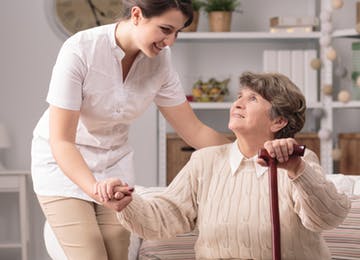Are Balance & Vestibular Disorders a Big Deal?

By: Jeff Ladinsky, PT, DPT, MTC, CCI
September is Fall Prevention Awareness Month an opportunity for physical therapists and physical therapist assistants nationwide to educate about who we are and what we do to effect balance disorders – one of the fastest growing group of diagnoses that physical therapists often treat. These disorders can frequently affect normal motion, limiting activities of daily living. However, people who suffer from balance impairments no longer have to learn to live with it because vestibular rehabilitation programs may provide those affected with an alternative management strategy. Physical therapists have become key members of the evaluation and rehabilitation team for patients with motion intolerance and balance disorders. With approximately 90 million American adults having experienced some form of vestibular disorder, the management of these patients can be challenging and also be among the most rewarding encounters for both patients and clinicians to experience.
Are balance disorders a big deal? You bet it is! Dizziness/loss of balance is the third most common complaint to physicians by patients over the age of 65. It is estimated that we have spent over $60 billion on treatment in the United States in 2017. Contrary to popular thought, balance deterioration is not caused by aging. Rather, it is due to decreasing levels of activity. Inactivity causes the balance system to weaken, much like a muscle that isn’t used.
Balance is actually a complicated function, organized by signals the brain receives from the eyes, muscles/ joints and from the inner ear, which contains semicircular canals filled with moving fluid. Eye movements give the brain visual information such as surface conditions, depth perception and reports on other external influences that may affect our position. Head movements stimulate the inner ear by moving the fluid through the canals, thus sending messages to the brain about the position of the head in relation to being upright. Lastly, our sense of touch and pressure sensors in our lower extremity joints, relay information regarding our body position. The brain interprets these signals and then sends orders to the eyes and to the muscles to properly respond to the received information.
Impairments in one or more of these sensory systems could mean difficulty in assuming and maintaining normal equilibrium in our never ending battle against gravity. For example, when the inner ear sends the brain incorrect information, or conflicting signals, the person may feel dizzy. The usual response to this sensation is to limit movement so as to minimize the rocking or spinning sensations. This is the case with the most common inner ear problem, benign positional paroxysmal vertigo (BPPV). This problem is caused by free-floating calcium “crystals” that may adhere to each other and affect the movement of the fluid of the inner ear. In treating such cases, the specially trained physical therapist positions and moves the patient’s head in a way that causes the crystals to dislodge from the inner ear. This condition most often can be relieved in a single treatment session.
Other balance disorders can be effectively addressed through a specific form program of movements called vestibular rehabilitation therapy. Covered by Medicare and most insurance, vestibular rehabilitation involves special exercises to help a patient with a balance disorder accommodate to the balance problem to diminish recurrent symptoms. It is based on the concept that the very movements that make the patient dizzy can eventually relieve the symptoms through repetition (theory of neuroplasticity). By repeatedly bombarding the brain with the correct movement patterns, the brain is ultimately forced to adapt, accepting and reinterpreting the faulty signals as correct. When that happens, the symptoms can subside. The treatment includes a home-exercise program custom-designed for each patient; it includes habituation and adaptation exercises, like lying down on one’s side then return to sitting. The home program is constantly revised as the patient improves. The exercises must be carefully monitored by a physical therapist because too much activity too soon can be counterproductive. Additionally, with some balance retraining exercises, progression from standing on a solid surface may be progressed to standing on a thick piece of foam rubber with eyes open or closed, for example, forcing the brain to rely on information from the inner ear rather than messages from the eyes and the feet. The exercises are often times so simple that many patients are skeptical at first that they can work!
If appropriate, vestibular rehabilitation patients are given eye exercises that retrain the vestibular ocular reflex, an adjustment controlled by the inner ear that allows the eye to keep the field of vision steady as a person moves. The eye exercises, in which patients may repeatedly move their heads from side to side or up and down while focusing on a specific target, like a letter taped to the wall, help patients steady their gaze.
Does vestibular therapy work? Studies show that vestibular therapy will commonly eliminate BPPV. It can reduce fall risk. Most patients will improve with this therapy to some degree. What it cannot do is keep your 25 year old mind from getting ones older body in trouble!
Also, if you are interested in learning more about patient mobility and rehabilitation, check out my course, “The Latest Advances in Patient Mobility,” here: https://summit-education.com/c/GMOBJL.1/